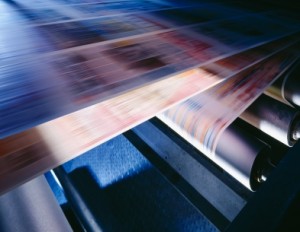Will Inkjet Printing Kill Offset?


But now offset faces a threat from two fronts. On the one side, high-speed toner-based printing devices have been taking over the short-run end of the market (usually defined as 5,000 copies or less). And now, thanks to breakthroughs in speed, high-end inkjet devices are gaining ground as well.
For one interesting take, see this article from printing-industry veteran Andy Tribute.
My assessment is that at present I see the new high-speed inkjet presses challenging offset in many areas such as books, magazines, and direct mail in run lengths up to 4,000 - 5,000 copies and in two years time up to 7,000 copies. However, I don't see it becoming competitive above 10,000 copies until beyond 2015. This is because the speed of print head development will not proceed at the high rate it has been going over the past few years in speed increases while at the same time improving imaging quality. I also don't see the inkjet companies dropping their ink prices enough over that time to really change the business equation.
And for a counter point, check out this blog from another printing industry guru Howie Fenton.
Ultimately, the print buyer should be aware of the differences in quality, cost and the ability to customize associated with each printing technology. The printer, in order to decide what equipment he requires, must understand how the needs of his customer base are met by each technology. There is no room in today's highly competitive marketplace to invest in the wrong machine.
Both writers make good points, but Doc thinks they are missing a few obvious ones. First, inkjet and toner printing will get even faster and cheaper as time moves on, meaning more and more jobs will be produced using those methods. Even if it doesn't make perfect economic sense to use inkjet or toner, the advantages in turnaround time will cause more people to utilize those methods.
Second, as variable-data printing gains ground, then you almost have to use inkjet or toner methods in order to customize the copies coming off the back end (offset is good at long runs but not at customization).
And third, inkjet and toner printing open up whole new markets for shorter-run jobs that may not have been cost effective a few years back. This means that more and more in-house operations will be doing their own printing in batches, as needed. So instead of producing 120,000 catalogs once a year, they may produce 10,000 catalogs each month, updating as they go along.
It all adds up, in Doc's mind, to a lessening of dependence on offset printing. I'm already seeing many jobs that once were produced using offset going in-house on high-speed toner or inkjet devices.
None of this is good news for those companies that make offset printing presses, but we are seeing increases in the sales of inkjet and toner machines. One of the disadvantages of offset printing is that most offset presses are not "on the network," and require a hand-off to a commercial printer. In our highly networked document world these days, the printing device almost has to be part of the network, and that's where toner and inkjet have a strong advantage.